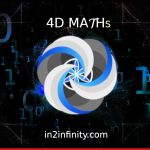Hi, Good day everybody, this is Colin Powell from in to infinity. And today we’re going to be looking at a little bit about time and space ratios in fourth dimension. So this if you’d like to learn more about fourth dimensional mathematics, you can go to into infinity comm and check it out. But today, we’re going to be discussing some of the foundations for the equation of of why this equation some people have to move the equation. You know, why this equation? Why not some other equation for the infinite mathematic? Yeah, so I’ll just give you an equation it’s x plus or minus, or plus or minus x divided by plus minus y. And then we bracket that and we plus or minus y actually looks like a kind of funny equation because you have plus or minus x and then a line plus minus y, and then you put a plus minus y next to it. It’s an XY space. This one this is what we call zero squared. And it gives us the time function, which is equal in both cases of y and z is is equal to y in this case, if we were to change, say the plus one for z, then we get into 03 space, but we’re just going to deal with 02 For the moment zero squared. So we can get an idea about how that works. Right. So so what we said was we generally perform mathematical functions in zero space on across two number lines. 990 degrees to each other works quite well for zero squared. And the reason is, if you think about it is because, you know, when we do a calculation, you could think that x could be a number that is in the positive, or it could be a number in the negative and y could be a number in the positive only wonder number in the negative so those lines we could call x y. But instead of doing that, because we’re in 4d space, sometimes what we like to do is call it ABCD. So we make a cross let’s draw that and would start with a at the top and the north, north, east will be B, South C. West will be D. Yeah, make a kind of compass. And that’s the reason we do that is because order matters. Remember that in fourth dimensional mathematics and so when we do calculations on the cross, we want to do simultaneous calculations, we want to simultaneously calculate, what is it? If I do three, let’s say three times one, and then we want to be able to simultaneously calculate what happens if I do one times three. There you don’t need to do that in normal mathematics, but in 40, that’s what we need and that’s what we we use the cross form. And so what happens is we can we can do typical balancing functions and things like that through that. So anyway, we’ll get more into some of that stuff later. But we’re going to go through now and just explain why why that is. Yeah. So let’s say that. Let’s say that we can have a plus plus, can’t we? Yeah. Y can be in a situation of plus plus, yeah. Y could be in a situation of plus minus y could be a situation in minus minus. And it could also be in a situation of minus plus then yeah, we’re just looking at Y for the moment. So it’s this cross represents now the y function and as NCM in different states. And that’s what we’re going to map we’re gonna map that. Yeah. And so now let’s compare that so let’s say all of those different states can be combined in some kind of way. Yeah. So let’s say a can be combined with A, B, C, or D. And so you get a B, a C, A D. Those are the combination three of the x y’s on the we can go double a why? Why? Because we’ve got two y’s in there. So that’s we’re going to use in an if you’re going to 03, it gets a little bit more complicated, but I’ve just given you the basics. So that’s why we can have a anyway otherwise it would be normally a Z, which would be the zero squared constant. And then you get a lot more options on the on the simultaneous calculation, but in theory squared, it’s a little bit simpler. So we’ll stick with a bb, bb BC BD BA. Yeah, that’s another round isn’t it? Yeah. B CC CD ca CB has another round. And DD DA DB DC is another four sets there and each containing four things each. So for every we add those up, that’s for four, isn’t it? Yep. And what we can do is, we’re going to bring in our X Factor, so our x factor could be in two states as well. You can be an A plus or minus Yep. So we can just add that onto there. It can be plus or minus. Yep. And those are kind of view like number states. And so if if it’s a plus or minus, and then you’ve got, you can double that four into eight. And so now we’ve got 41234 time or eight sets of eight. Yeah, because four for the minus four for the minus x and four for the plus x for all the A’s for for the minus x four for the plus x for the B’s for and so on. Yep, yeah. So eight plus eight plus eight plus eight, and that equals 32. So 32 is a really important number, particularly when it comes because we’ve made it through just giving it a positive, a negative function, and I explained why. But in the atom, as we watch the atomic shells build, what we notice is that the the, at each time, like say a shell completes, that the number of electrons is expanding. Yeah, so let’s divide it into positive and negative in the electrons, so every electron has a kind of opposite, if you like, yeah, like all like, I mean, it’s a bit of a there’s a reason for that, is that the way science has done it, but it’s just the way that you have like what they call a positron and an electron at all states. So there’s a there’s an electron there is a kind of negative electron. Yeah, just think of it like that. And so and so basically, what we’re really saying is that the as they go up, they expand through square numbers. So one will turn in well, we have a one negative one positive in a way and we add those together. And we get to we get helium so and then when we get the next one will add to that four on one side and a four on on the positive four in the negative. And we get to the next shell, which is the next noble gas, which is neon. Yeah, and it’s eight plus the two from before so you see there’s 10 and we go on like that we we add more and more shells, and it carries on and it constructs the atom in a particular kind of way. And so once that shell completes, it’s done. And then the next shell want to come up and say right, I want to make an SPD and I’m going to try and make an d orbital now. So when he does that, it still follows the same pattern. There’s a little kink in the pattern as well. So but the bottom line is is that when you look at the electron configuration and you can go to electron figuration chart and look at this, is that you’re only going to have one to 32 electrons maximum in a shell. And that’s great for four dimensional mathematics, you know, because that’s exactly the ratio when we look at the ratio of one calculation x, if you think it provides us with 32 potential outcomes. And so, this is how we can start to collapse the Schrodinger equations more easily. Because simultaneous equation is a very powerful thing. And we can represent that in a multi dimensional space using a computer. And so what we’re going to receive then is not just a dry kind of mathematical equation that we have to kind of wrap our head around, we’re going to see a shape and by seeing that shape, you’re going to understand a lot more about how the algorithm works and how it functions. And so I’m just giving you a little thing now a little bit of a breakdown about some of the simultaneous calculations and and quantum calcular Kalita that you can kind of construct to construct a proper calculator you need to produce all 32 results simultaneously from just an x and a y. Yep, so that’s it. Yeah. So then you can say x, y equals that. And then we’ve got 32 results that equal the other one. And what you will find is that as we as you move through the time function that because 32 is a time function, it will give you a number of a DRG generation function does look at like kind of how an atom disintegrates. You see, and you’ll get this infinity wave. And that will tell you a lot more also about how atoms work and things like that. In the periodic table, we think yeah, because you’ve got 81 stable elements goes up to 83. And you can put space in as the as the now the elemental function. And time can be the electron function. And so we can we can make translations into that space. That’s very, very exciting for quantum physicists, mathematicians and all that stuff. Because it allows us to have a look at a mathematical quantum microscope into numbers that marries with the exact blueprint of the atomic space. So that’s me, that’s Colin Powell for this week. Hope you enjoyed that little presentation or four dimensional mathematics. And I’m sure that those enthusiasts of fourth dimensional mathematics are going to be busy coding up atomic calculators from now on, and we look forward if you do have a good result. You know, I’m very busy at the moment. But if you do have a positive result, yeah, share it with us. We’d love to see the fourth dimensional who’s going to be the first to build a fourth dimensional atomic calculator properly in some using proper code. It’d be fun. Okay, anyway, my name is Colin Powell into infinity. If you want to find out more, is our website good into infinity.com? No, get involved, you know, sign up on mailing list all the other stuff. We really like to stay connected as we pioneer, the fourth dimension, thinking forward into the future. Thank you very much. And all the best and have a great day.
Prime number structure
Hi, and welcome to another broadcast from inter infinity, where we’re talking about fourth dimensional mathematics. And today we’re having


